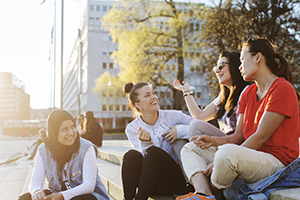About the project
The project Dialectal identities in late modern Norway, led by Unn Røyneland, comprises a number of studies of language attitudes toward accented Norwegian, dialect variation and the use of dialects by the immigrant population. A central question posed in the project is: “What should you sound like to sound like you belong — and what should you look like?” The main aim of the project is to examine what conceptions young people in Norway have of the connections between language, body and place, and to assess the extent to which young people with immigrant backgrounds are perceived as authentic and entitled users of local dialects.
Data
For this project, data was collected from 605 students at 11 different secondary schools in 6 different urban and rural locations in Eastern and Western Norway. The extensive dataset consists of an online questionnaire, visual-verbal guise tests, foreign accent comprehension tests and focus group interviews.
Results
One main hypothesis, which has been confirmed in the analyses, is that boys with immigrant backgrounds are evaluated as far more “Norwegian” when they speak a dialect other than the Oslo dialect. Interestingly, this does not seem to be the case when it comes to the girls. They are evaluated as equally Norwegian regardless of the dialect they use. Overall, both boys and girls with immigrant backgrounds are evaluated equally positively as boys and girls with a majority background. The use of non-Oslo dialects is generally evaluated very positively. However, boys are evaluated as considerably “cooler” when they use the Oslo dialect. Another main finding is that accented non-Oslo dialects are evaluated more positively than the Oslo dialect. Non-Oslo dialects may function as a “camouflage” of an accent: young people simply do not seem to hear the accent in dialects that are not their own.
Collaborators
Collaborators include Associate Professor and Department Head of Research (and MultiLing affiliate) Toril Opsahl (UiO); Professor Lars-Anders Kulbrandstad (Hedmark University College and UiO); MA student and research assistant Kristin Myklestu (UiO); MA student Ragni Vik Johnsen (UiO); and statistician Bård Uri Jensen (UiO).
.jpg)
Publications and presentations
Results from the studies are presented in two MA theses: Myklestu (2015) and Vik Johnsen (2015), Røyneland (2016, in press): Hva skal til for å høres ut som du hører til? Forestillinger om dialektale identiteter i det senmoderne Norge [What should you sound like to sound like you belong? Conceptions of dialectal identities in late modern Norway]. Nordica Helsingiensia, and several articles are in the pipeline. Results from the project have also been presented at international conferences: The Sociolinguistics of Globalization (June 2015) in Hong Kong, China, LANCHART-conference (October 2015) in Copenhagen, Denmark, North/South Dialogues, Johannesburg, South Africa, INPART kick-off workshop (March 2016), Stellenbosch, South Africa, the workshop Dialect acquisition and migration (April 2016), MultiLing, Norway, SONE-conference (April 2016), Oslo, Norway, Sociolinguistic Symposium 21 (June 2016), Murcia, Spain.
Link to MultiLing Annual Report (2015)
